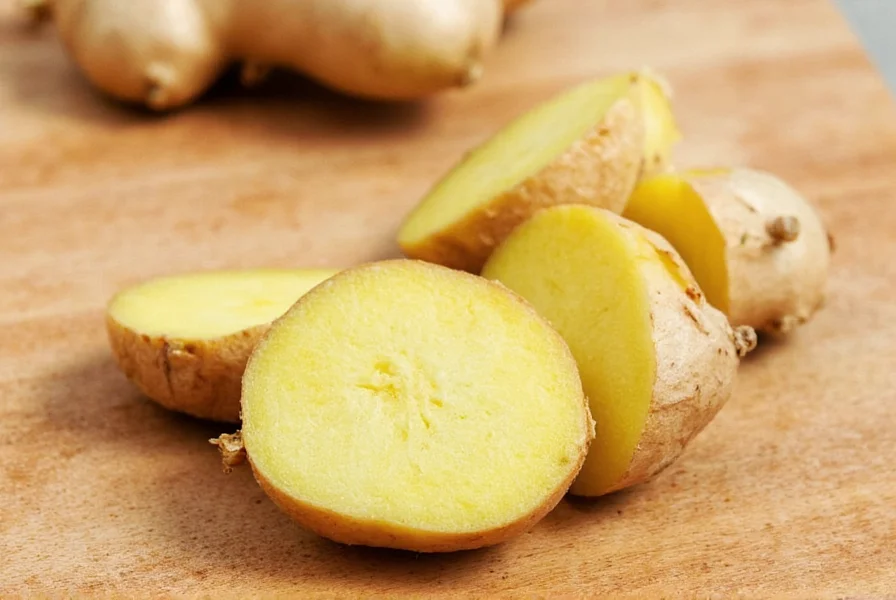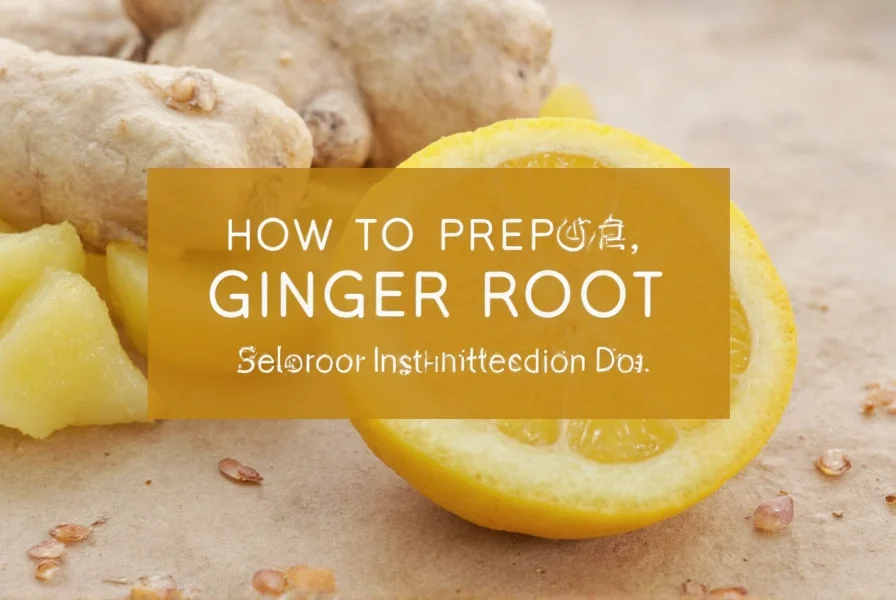Peeling ginger root is simplest with a spoon: scrape the skin off using the edge of a teaspoon, which follows the root's contours without wasting flesh. For slicing, cut thin rounds across the fibers; for grating, use a microplane for fine zest or box grater for coarser texture. Fresh ginger should be firm, smooth, and aromatic with no wrinkles or mold. Store unpeeled roots in a paper bag in the refrigerator's crisper drawer for up to three weeks.
Selecting Quality Ginger Root
Choosing fresh ginger is the first critical step in proper preparation. Look for plump, firm roots with smooth, taut skin that feels heavy for its size. High-quality ginger should have a spicy, citrusy aroma when scratched. Avoid specimens with wrinkles, soft spots, or visible mold. Young ginger has thinner skin and higher moisture content, making it easier to prepare, while mature ginger has a stronger flavor but thicker skin requiring more careful peeling.
Essential Ginger Preparation Techniques
Master these fundamental methods to maximize flavor and minimize waste when working with ginger root:
Peeling Methods Compared
| Method | Best For | Advantages | Disadvantages |
|---|---|---|---|
| Spoon scraping | All ginger types | Minimal waste, follows contours | Requires practice |
| Vegetable peeler | Young ginger | Fast, efficient | Wastes more flesh on knobby roots |
| Knife peeling | Mature ginger | Precise control | Higher waste, safety risk |
The spoon method consistently produces the best results for most home cooks. Hold the ginger firmly and use the edge of a teaspoon to gently scrape away the skin. The curved edge easily follows the root's natural shape, removing only the papery skin while preserving valuable flesh beneath.
Slicing and Cutting Techniques
For even cooking and optimal flavor release, cut across the grain of the ginger fibers. For stir-fries, slice into thin matchsticks (julienne); for soups and stews, cut into coins about 1/8 inch thick. When making ginger tea, thicker slices (1/4 inch) work best as they release flavor more gradually. Always use a sharp chef's knife on a stable cutting board for safety and precision.
Grating Methods
Microplane graters produce the finest texture ideal for marinades and dressings where you want ginger flavor without noticeable pieces. Box graters work well for recipes where you want more texture, like ginger cookies. For maximum juice extraction, freeze the ginger first—frozen ginger grates more easily and releases more liquid. Never use pre-grated ginger from jars for best flavor and health benefits.

Advanced Ginger Preparation Methods
Making Ginger Juice
For potent ginger flavor in beverages or dressings, extract fresh juice by grating peeled ginger, then squeezing the pulp in a clean cheesecloth or fine mesh strainer. One ounce of fresh ginger yields approximately one teaspoon of concentrated juice. This method preserves volatile compounds lost in dried ginger powder.
Creating Ginger Syrup
Simmer equal parts water and sugar with thinly sliced ginger for 20 minutes, then strain. This versatile syrup enhances cocktails, teas, and desserts while preserving ginger's beneficial compounds. Store in the refrigerator for up to two weeks.
Pickling Ginger (Gari)
Thinly slice young ginger, blanch briefly, then submerge in a mixture of rice vinegar, sugar, and a pinch of safflower for color. This traditional Japanese preparation creates the pink ginger served with sushi and aids digestion.
Proper Storage Techniques
Understanding how to store ginger properly extends its shelf life and maintains quality. Unpeeled roots last longest when stored in a paper bag in the refrigerator's crisper drawer—up to three weeks. Peeled ginger should be submerged in sherry or vodka in an airtight container (two weeks refrigerated). For long-term storage, freeze whole unpeeled roots (six months) or grated ginger in ice cube trays covered with water (three months).
Common Ginger Preparation Mistakes
Avoid these frequent errors that compromise ginger's flavor and texture:
- Using dull knives that crush rather than cut ginger fibers
- Peeling too deeply and wasting valuable flesh
- Using pre-minced ginger from jars (loses volatile compounds)
- Storing ginger in plastic bags (traps moisture causing mold)
- Not adjusting preparation method for recipe requirements
Safety Considerations
While generally safe, proper ginger handling prevents kitchen accidents. Always cut away from your body with a sharp knife. Wear gloves if you have sensitive skin, as ginger's natural oils can cause irritation. Discard any ginger with mold—unlike some produce, mold penetrates deep into ginger's fibrous structure. People on blood thinners should consult their physician about ginger consumption, as it has natural anticoagulant properties.
Practical Applications
Different preparation methods suit specific culinary applications. For baking, finely grated ginger distributes flavor evenly. In savory dishes, sliced or julienned ginger provides texture contrast. For tea, bruised chunks release flavor gradually during steeping. When making ginger shots, use a high-powered juicer for maximum extraction. Understanding these nuances transforms your cooking and ensures you get the most from this versatile root.
What's the easiest way to peel ginger without wasting flesh?
The spoon method is most efficient: use the edge of a teaspoon to scrape off the papery skin. The curved edge follows ginger's natural contours, removing only the thin outer layer while preserving valuable flesh. This technique works for all ginger varieties and minimizes waste compared to knife or peeler methods.
How should I store freshly prepared ginger?
Store grated or sliced ginger in an airtight container covered with sherry or vodka in the refrigerator for up to two weeks. The alcohol preserves flavor while preventing mold. For longer storage, freeze prepared ginger in ice cube trays covered with water, then transfer to freezer bags for up to three months. Never store prepared ginger in plain water as it dilutes flavor and promotes spoilage.
Can I use a food processor to prepare ginger?
Yes, but with caution. Pulse peeled ginger in short bursts to avoid turning it into paste. For best results, cut ginger into 1-inch pieces first and use the shredding disc for consistent texture. Food processors work well for large quantities but lack the precision of hand-grating for delicate recipes where texture matters.
Why does my ginger taste bitter after preparation?
Bitterness usually comes from over-processing or using damaged ginger. Avoid grating too finely or processing for extended periods, which releases bitter compounds from the fibrous parts. Also check that your ginger isn't past its prime—wrinkled or soft ginger develops unpleasant flavors. For best results, use fresh, firm ginger and stop processing when you achieve the desired texture.
How do I prevent my fingers from smelling like ginger?
Rub your hands with lemon juice or vinegar immediately after handling ginger, then wash with soap and water. Stainless steel soap bars also effectively neutralize ginger odors when rubbed under running water. Wearing thin food-safe gloves during preparation prevents odor transfer entirely while maintaining dexterity.











 浙公网安备
33010002000092号
浙公网安备
33010002000092号 浙B2-20120091-4
浙B2-20120091-4